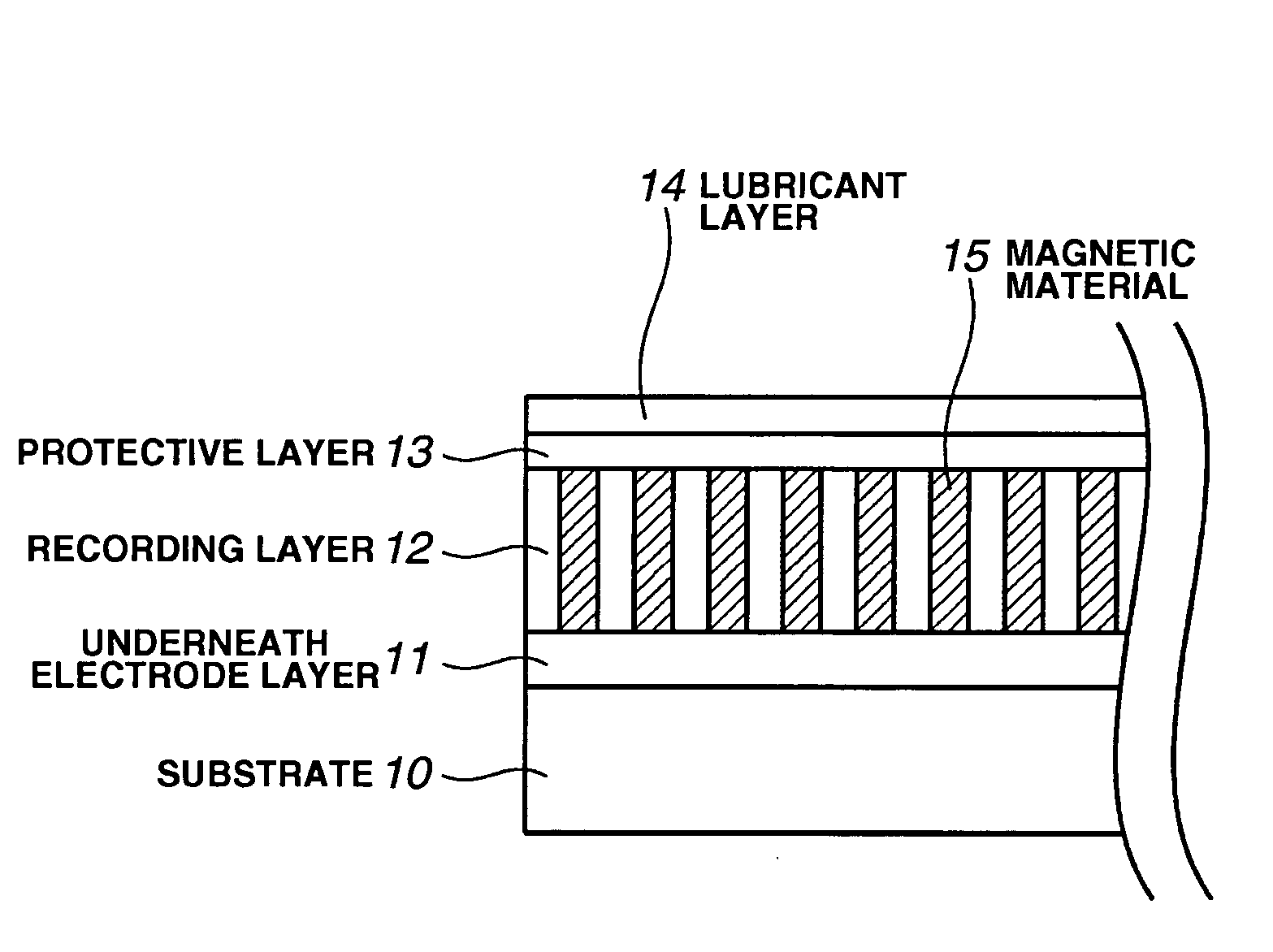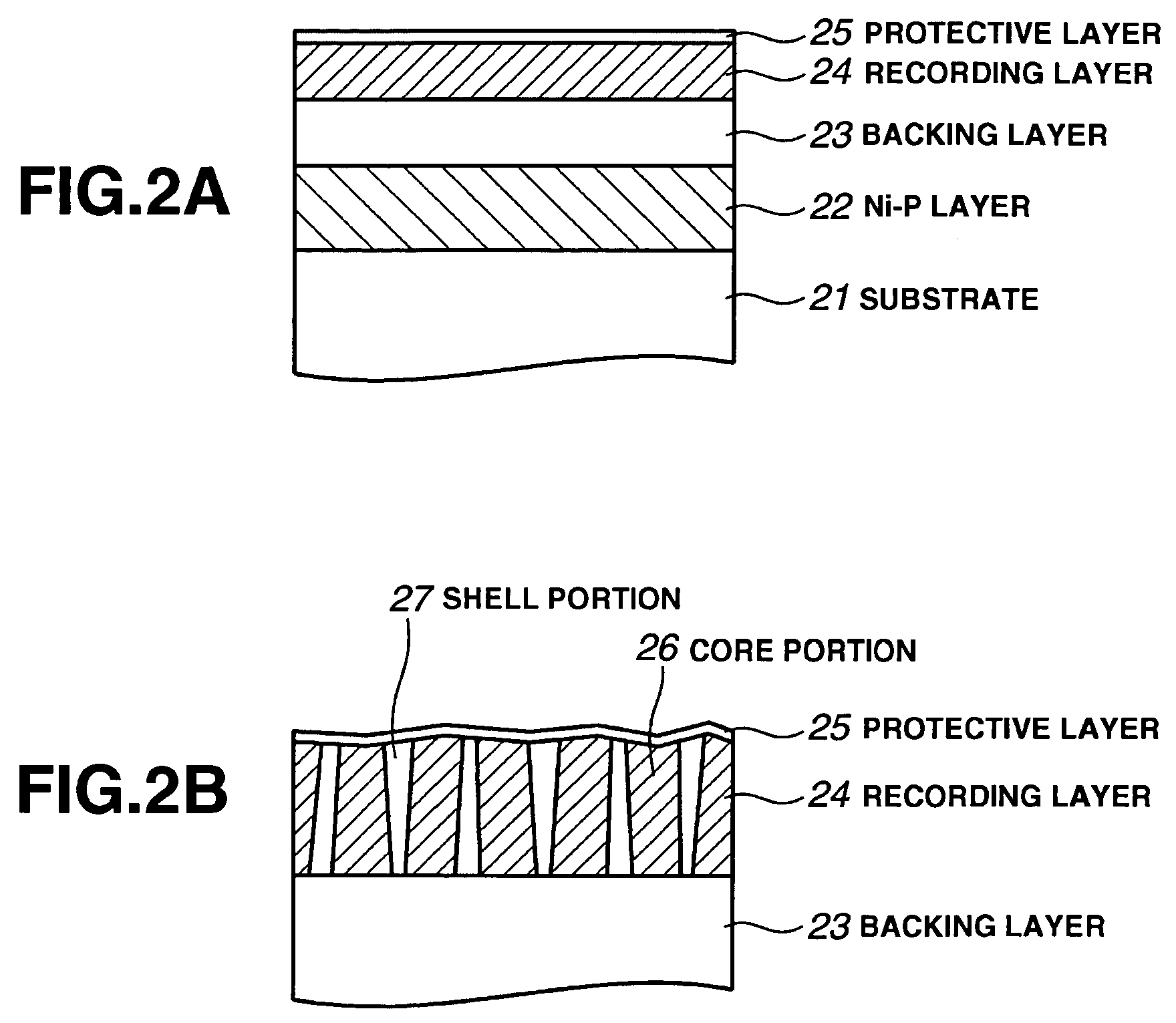Cobalt-platinum or iron-plantinum magnetic material containing 1% to 40% Cu, Ni or B
- Summary
- Abstract
- Description
- Claims
- Application Information
AI Technical Summary
Benefits of technology
Problems solved by technology
Method used
Image
Examples
example 1
[0064]Example 1 of the present invention relates to a three-element magnetic material including a plated CoPt- or FePt-alloy.
[0065]First, a basic plating solution for CoPt including 0.3 mol / l of cobalt sulfate, 0.01 mol / l of hexachloroplatinic acid, and 30 g / l of boric acid was prepared. Similarly, a basic plating solution for FePt including 0.3 mol / l of iron sulfate, 0.01 mol / l of hexachloroplatinic acid, and 30 g / l of boric acid was prepared. It was confirmed that CoPt and FePt were deposited from these solutions, and were transformed into L10-ordered alloys at annealing temperatures of 700° C. and 600° C., respectively, in a vacuum. However, the magnetic material of the present invention may be deposited by using any other appropriate plating solution, and components other than the above-described ones are not excluded. In addition, various combinations of materials may, of course, also be used.
[0066]By adding 0.005 mol / l of copper sulfate to the above-described basic plating sol...
example 2
[0069]Example 2 of the present invention relates to a four-element magnetic material including a plated CoPt- or FePt-alloy.
[0070]A new plating solution was prepared by adding 0.1 mol / l of nickel sulfate, 10 g / l of sodium citrate, and 1 g / l of trimethylamineborane to the basic plating solution for each of CoPt and FePt described in Example 1.
[0071]Composition analysis cleared that Ni and B were added to the CoPt and FePt to form respective four-element alloys. For effectively adding B, eutectoid with Ni is effective. A Pt film 20 nm thick formed on a silicon substrate was used as the substrate, and electrodeposition was performed at a bath temperature of 60° C. and a current density of 1 A / dm2.
[0072]By annealing the above-described deposits obtained by electrodeposition at 500° C., the deposits were transformed into L10-ordered alloys whose coercive forces increased by about 35% and about 70% in Co30NI20Pt46B4 and Fe28Ni22Pt45B5, respectively, and have coercive forces equal to or mo...
example 3
[0073]Example 3 of the present invention relates to a magnetic recording medium using a magnetic material according to the present invention.
[0074]A doughnut-shaped glass substrate was prepared, and a MgO film 10 nm thick having (001) orientation in a direction perpendicular to the substrate, a Pt film 20 nm thick having (001) orientation, serving as the underneath electrode layer, and an AlSi structure 30 nm thick formed from a sputtering target having a composition ratio of 56% of Al and 44% of Si were successively formed according to sputtering. The AlSi structure is characterized in that Si portions surround cylindrical aluminum portions.
[0075]In order to form pores by removing the aluminum portions of the AlSi structure, the structure was immersed into 2.8 mol % of aqueous ammonia for 10 minutes at the room temperature. At that time, the Pt surface having (001) orientation is exposed at the base of pores. By removing the aluminum portions, a structure as shown in FIGS. 3A and 3...
PUM
| Property | Measurement | Unit |
|---|---|---|
| Temperature | aaaaa | aaaaa |
| Fraction | aaaaa | aaaaa |
| Fraction | aaaaa | aaaaa |
Abstract
Description
Claims
Application Information
 Login to View More
Login to View More - R&D
- Intellectual Property
- Life Sciences
- Materials
- Tech Scout
- Unparalleled Data Quality
- Higher Quality Content
- 60% Fewer Hallucinations
Browse by: Latest US Patents, China's latest patents, Technical Efficacy Thesaurus, Application Domain, Technology Topic, Popular Technical Reports.
© 2025 PatSnap. All rights reserved.Legal|Privacy policy|Modern Slavery Act Transparency Statement|Sitemap|About US| Contact US: help@patsnap.com



